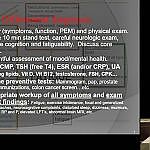Dr. Natelson has found that about 20% of people with chronic fatigue syndrome (ME/CFS) either hyperventilate or take rapid, shallow breaths when they stand. (A small percentage may hyperventilate when they lie down as well.) Other studies suggest that hyperventilation and other altered breathing patterns during exercise may be common.
(Note that rapid, shallow breathing is NOT hyperventilation (even though most people think it is). Rapid, shallow breathing is hypoventilation ("underbreathing") - which restricts CO2 from leaving the lungs - and can lead to hypercapnia, not hypocapnia. The bag breathing exercise below will not work with rapid, shallow breathing. You should be breathing less than 15s a minute. )
Hyperventilation ("overbreathing") involves taking DEEP breaths, which allows more CO2 to leave the lungs, resulting in low CO2 levels. The bag-breathing exercise below makes sense in overbreathing because it returns CO2 to the lungs and blood.
The reduced blood CO2 levels caused by hyperventilation can cause fatigue, pain, and many of the other symptoms often found in ME/CFS, fibromyalgia, postural orthostatic tachycardia syndrome (POTS), and long COVID.
Two Tests For Hyperventilation
A Simple Hyperventilation Test
Am J Physiol Heart Circ Physiol. 2006 Aug;291(2):H904-13. Epub 2006 Mar 24.Postural hypocapnic hyperventilation is associated with enhanced peripheral vasoconstriction in postural tachycardia syndrome with normal supine blood flow.,Stewart JM1, Medow MS, Cherniack NS, Natelson BH.
Hypocapnia is a biological marker for orthostatic intolerance in some patients with chronic fatigue syndrome. Natelson BH, Intriligator R, Cherniack NS, Chandler HK, Stewart JM.
Dyn Med. 2007 Jan 30;6:2.
(Note that rapid, shallow breathing is NOT hyperventilation (even though most people think it is). Rapid, shallow breathing is hypoventilation ("underbreathing") - which restricts CO2 from leaving the lungs - and can lead to hypercapnia, not hypocapnia. The bag breathing exercise below will not work with rapid, shallow breathing. You should be breathing less than 15s a minute. )
Hyperventilation ("overbreathing") involves taking DEEP breaths, which allows more CO2 to leave the lungs, resulting in low CO2 levels. The bag-breathing exercise below makes sense in overbreathing because it returns CO2 to the lungs and blood.
- Check out Natalie's Casebook for a more detailed explanation of hyperventilation and hypoventilation
The reduced blood CO2 levels caused by hyperventilation can cause fatigue, pain, and many of the other symptoms often found in ME/CFS, fibromyalgia, postural orthostatic tachycardia syndrome (POTS), and long COVID.
Two Tests For Hyperventilation
A Simple Hyperventilation Test
- Most people can hold their breath for 45 seconds or more. Take a breath and hold it: if you can only hold your breath for 35 seconds or less, you could be a chronic hyperventilator.
- Stand up straight for 8 minutes.
- If you start to feel ill, stop and rest for a while.
- Repeat the test, but this time breathe into a paper bag held across your nose and your mouth. If your symptoms disappear when you breathe into the bag, you may be hyperventilating.
- Find out how to do the NASA lean test here to learn if you might have a form of orthostatic intolerance (OI). OI refers to conditions in which you become symptomatic when you are upright (sitting or standing or both).
- Move Over POTS: Hypocapnia may be a Bigger Deal
- 2025 Interview with Dr. Natelson
Am J Physiol Heart Circ Physiol. 2006 Aug;291(2):H904-13. Epub 2006 Mar 24.Postural hypocapnic hyperventilation is associated with enhanced peripheral vasoconstriction in postural tachycardia syndrome with normal supine blood flow.,Stewart JM1, Medow MS, Cherniack NS, Natelson BH.
Hypocapnia is a biological marker for orthostatic intolerance in some patients with chronic fatigue syndrome. Natelson BH, Intriligator R, Cherniack NS, Chandler HK, Stewart JM.
Dyn Med. 2007 Jan 30;6:2.













